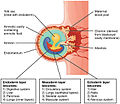Fetal membranes
Fetal membranes are structures that form around an embryo or fetus during pregnancy in mammals, including humans. They are composed of the amnion, the chorion, the yolk sac, and the allantois. These membranes play crucial roles in the protection, nourishment, and development of the fetus.
Structure[edit]
The fetal membranes are composed of four main components:
- Amnion: This is the innermost layer of the fetal membranes. It forms a protective sac around the fetus and is filled with amniotic fluid, which cushions the fetus and maintains a constant temperature in the womb.
- Chorion: This is the outermost layer of the fetal membranes. It contributes to the formation of the placenta, which provides oxygen and nutrients to the fetus.
- Yolk sac: In humans, the yolk sac is responsible for the initial circulation and is a source of primordial germ cells. It also contributes to the development of the umbilical cord.
- Allantois: This structure is involved in early fluid exchange between the embryo and the yolk sac.
Function[edit]
The primary function of the fetal membranes is to protect and nourish the fetus. The amnion and chorion create a barrier against physical impact, bacterial infection, and maternal immune cells. The chorion and its villi also facilitate the exchange of nutrients and waste products between the mother and fetus.
The yolk sac provides nutrition to the early embryo before the placenta is fully formed. The allantois aids in gas and waste exchange.
Clinical significance[edit]
Damage or disease in the fetal membranes can lead to complications in pregnancy, such as preterm birth, intrauterine growth restriction, and preeclampsia. In some cases, the membranes may rupture prematurely, a condition known as premature rupture of membranes (PROM).
See also[edit]
References[edit]
<references />
-
Placenta with fetal membranes
-
Embryo Week 3
Ad. Transform your life with W8MD's Budget GLP-1 injections from $49.99


W8MD offers a medical weight loss program to lose weight in Philadelphia. Our physician-supervised medical weight loss provides:
- Weight loss injections in NYC (generic and brand names):
- Zepbound / Mounjaro, Wegovy / Ozempic, Saxenda
- Most insurances accepted or discounted self-pay rates. We will obtain insurance prior authorizations if needed.
- Generic GLP1 weight loss injections from $49.99 for the starting dose of Semaglutide and $65.00 for Tirzepatide.
- Also offer prescription weight loss medications including Phentermine, Qsymia, Diethylpropion, Contrave etc.
NYC weight loss doctor appointmentsNYC weight loss doctor appointments
Start your NYC weight loss journey today at our NYC medical weight loss and Philadelphia medical weight loss clinics.
- Call 718-946-5500 to lose weight in NYC or for medical weight loss in Philadelphia 215-676-2334.
- Tags:NYC medical weight loss, Philadelphia lose weight Zepbound NYC, Budget GLP1 weight loss injections, Wegovy Philadelphia, Wegovy NYC, Philadelphia medical weight loss, Brookly weight loss and Wegovy NYC
|
WikiMD's Wellness Encyclopedia |
| Let Food Be Thy Medicine Medicine Thy Food - Hippocrates |
Medical Disclaimer: WikiMD is not a substitute for professional medical advice. The information on WikiMD is provided as an information resource only, may be incorrect, outdated or misleading, and is not to be used or relied on for any diagnostic or treatment purposes. Please consult your health care provider before making any healthcare decisions or for guidance about a specific medical condition. WikiMD expressly disclaims responsibility, and shall have no liability, for any damages, loss, injury, or liability whatsoever suffered as a result of your reliance on the information contained in this site. By visiting this site you agree to the foregoing terms and conditions, which may from time to time be changed or supplemented by WikiMD. If you do not agree to the foregoing terms and conditions, you should not enter or use this site. See full disclaimer.
Credits:Most images are courtesy of Wikimedia commons, and templates, categories Wikipedia, licensed under CC BY SA or similar.
Translate this page: - East Asian
中文,
日本,
한국어,
South Asian
हिन्दी,
தமிழ்,
తెలుగు,
Urdu,
ಕನ್ನಡ,
Southeast Asian
Indonesian,
Vietnamese,
Thai,
မြန်မာဘာသာ,
বাংলা
European
español,
Deutsch,
français,
Greek,
português do Brasil,
polski,
română,
русский,
Nederlands,
norsk,
svenska,
suomi,
Italian
Middle Eastern & African
عربى,
Turkish,
Persian,
Hebrew,
Afrikaans,
isiZulu,
Kiswahili,
Other
Bulgarian,
Hungarian,
Czech,
Swedish,
മലയാളം,
मराठी,
ਪੰਜਾਬੀ,
ગુજરાતી,
Portuguese,
Ukrainian


